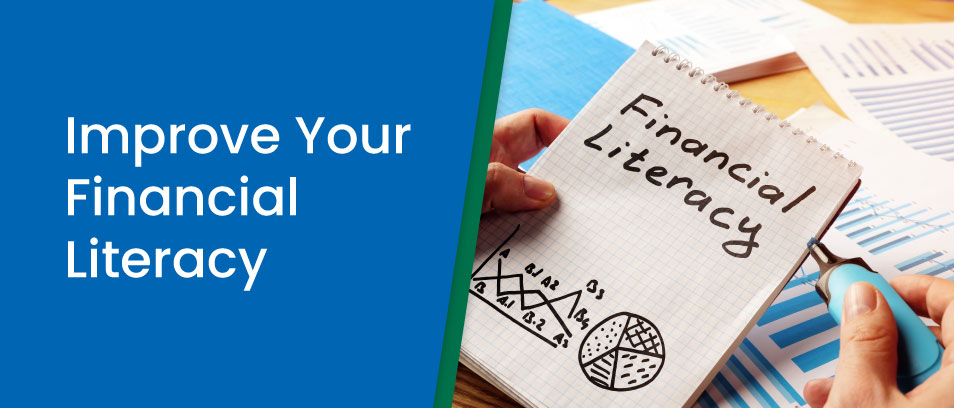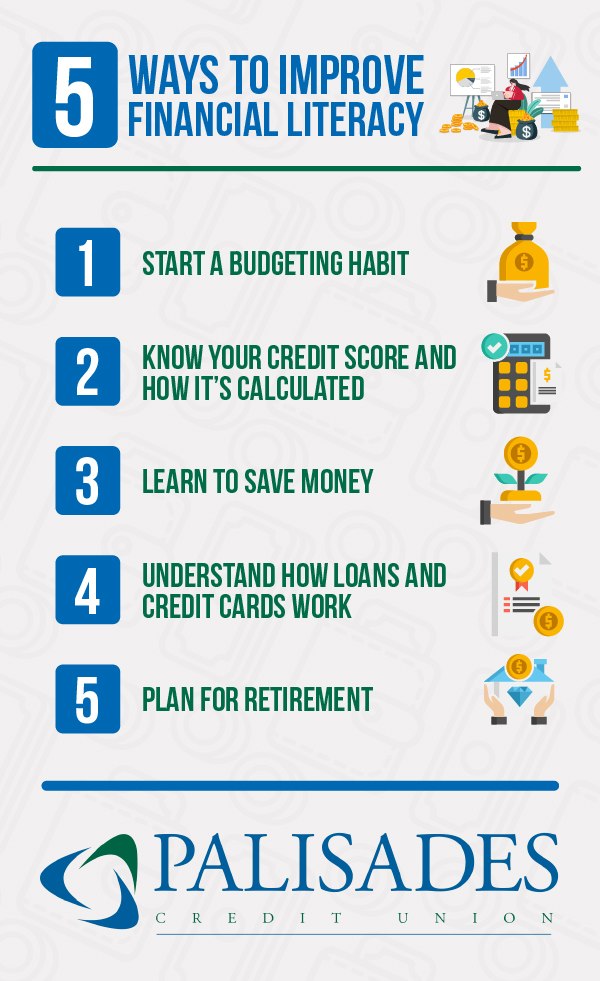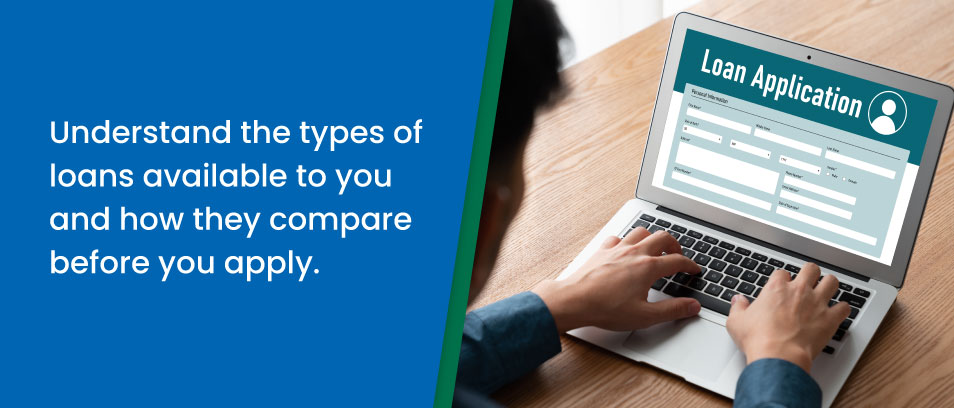Possessing financial literacy means you understand and use certain skills to manage your money. No one is born knowing how to create a budget or understand different options for saving and investing. Just as you need to learn how to read and do math, becoming financially literate is an important education for your future success.
While some schools offer financial literacy classes, this type of education isn’t available to every student. In this article, we’ll show you how to improve your financial literacy in six steps with a DIY education.

1. Start a budgeting habit
Simply put, a budget is your total income minus your fixed expenses. What’s left over can be divided between savings accounts and discretionary spending (aka “fun money”).
You can budget with pen and paper, a spreadsheet (search for “free budget spreadsheets”), or one of the numerous budgeting apps available in both free and paid versions. Our online banking platform also allows you to create budgets and set financial goals to work towards.
Don’t be discouraged if your first attempt at budgeting doesn’t go perfectly according to plan. You may have to try different approaches before you find the one that works best for you. Also, a budget is meant to be a flexible document, not set in stone. As you get started, you may need to make adjustments between what you thought was realistic and what actually happened. All of that is totally normal.
Looking for additional support with budgeting? The New York Public Library has a free “Money Matters” series of programs. They also offer free financial resources and free 30-minute sessions with a financial advisor. Check out all their financial literacy resources here.
If you like to listen to podcasts, there are lots of financial literacy ones out there. Search in your favorite podcast player or online.
2. Know your credit score and how it’s calculated
Your credit score is a three-digit number, ranging from 300-850, that has a major influence on your ability to obtain loans and other credit, as well as to rent an apartment. Some employers also do a credit check before extending an employment offer. So, understanding what a credit score is and how to keep yours in the good range is very important.
Of the various credit scoring models, the FICO® Score is the most popular. However, all types of credit scores are based on the same factors. Learn how to maintain a good score or improve a less-than-great score.
- On-Time Payment History: Make sure to pay all your bills on time. You can set up auto payments or schedule bill pay through our online banking platform.
- Credit Utilization Ratio: When using credit cards, it’s best to pay off the balance each month. But if you do need to carry a balance for a period of time, try not to use more than 30% of your credit limit on any account. Using more than that can hurt your score.
- Credit History: Having no credit history can hurt your score. So, open at least one credit account and keep it open even if you no longer use it.
- Credit Mix: Managing different types of credit, from credit cards to term loans, reflects positively on your credit score.
- New Accounts: A “hard check” when you apply for a new credit account can temporarily lower your score. Avoid opening a bunch of new accounts at once.
Get a free credit report from each of the three major reporting bureaus here. It’s a good idea to review your credit report at least once a year–report any errors or signs of fraud immediately.

3. Learn to save money
As the saying goes, pay yourself first by dedicating a certain amount of each paycheck to savings. If you don’t already have one, open a savings account to get started. You can set up a recurring transfer between your checking and savings accounts–put your savings on autopilot so you don’t have to remember to do it.
When your budget already feels pinched, you may think extracting anything for savings is too hard. Just start small–$25 from each paycheck or even $10. The point is to start a savings habit. As your income increases, or you cut certain expenses or pay off a debt, you can put some of that money towards savings, gradually raising your recurring savings transfer over time.
Identify your saving goals (retirement, a vacation, down payment on a home, etc.), but don’t forget to contribute to a general emergency fund. This will come in handy if you face a large unexpected expense or lose your job.
Once you’ve built up a nice nest egg in a basic savings account, consider leveling up your savings with a Money Market account or a Certificate. Both of these savings account options are FDIC insured up to $250,000 and they offer a higher interest rate than basic savings.
A Money Market is like a combination of a checking and savings account, with some check-writing privileges but it also earns interest. So, if you are saving for an expense such as a vacation or home improvement project, a Money Market is a great option. Certificates offer a higher interest rate in exchange for your commitment not to touch your deposit for a certain length of time. So, Certificates are a great option for growing your savings when you know you won’t need that money for the length of the term.
4. Understand how loans and credit cards work
As we mentioned in regards to credit scores, managing debt is an important part of having a healthy credit score and history. But, in order to use loans and credit cards responsibly, you first need to understand how they work and what the common pitfalls are.
Secured vs. Unsecured Debt
All types of loans fall into one of these two categories.
- Secured loans are tied to a physical asset, such as a house or car, and typically offer lower interest rates. If you default on a secured loan, your lender can seize the asset it’s tied to in order to recoup what they lent you.
- Unsecured loans are not tied to an asset. Approval is solely based on your creditworthiness. Interest rates are usually higher since, if you default on unsecured debt, there is no asset for your lender to seize.
Interest Rates
The interest rate on a loan is the cost of borrowing money. All loans have interest rates–the only exception is the grace period that comes with a credit card. If you pay off your balance every month, you won’t be charged interest on purchases. There are two types of interest rates:
- Fixed interest rates stay the same throughout the life of a loan. This type of interest rate is most common with a term loan, such as a mortgage, car loan, student loan, or personal loan. Your monthly payment stays the same and consists of paying back what you borrowed (the principal) plus interest.
- Variable interest rates fluctuate up or down depending on the benchmark rate they’re tied to. This type of interest rate is most common with a revolving line of credit, such as a credit card, though variable rate mortgage loans are also an option.
Credit Cards
While these small plastic payment cards look like debit cards, there is an important difference. Using a credit card to pay for purchases means you’re borrowing money, while a debit card draws the funds straight from your checking account.
Credit cards can be a convenient and rewarding payment method, but it’s also easy to get in trouble. If you charge more than you can afford to pay off each month, the hefty interest rate will be charged on your balance. Once you accumulate a balance, it’s much harder to dig out. So, don’t use credit cards to pay for discretionary expenses you can’t afford.
Car Loans
Buying a new or used car is a large expense. Most people cannot pay in cash for a vehicle purchase, so they finance it instead. The interest rate on a vehicle loan depends on your creditworthiness, as well as the age and condition of the car. Don’t just take whatever a dealer offers–you can shop around beforehand to find the best rate and terms. Banks and credit unions offer auto loans, too, in addition to dealerships.
Student Loans
For high school students who go to college, student loans are often the first type of debt you encounter. There are two types of student loans, federal and private. It’s generally recommended to exhaust your federal loan options first before turning to private student loans. Remember that you will have to start paying back your student loans within six months of graduating or leaving college. If you have more than one private loan, consider student loan consolidation for the convenience of having just one monthly payment instead of several.
Learn more about how to apply for student loans.
Mortgage Loans
Buying your first home is a significant personal milestone. It’s also the largest purchase most people will ever make. When the time comes, we can help you find the best mortgage loan option for you. In addition to mortgage loans for purchasing a home, you can also refinance your mortgage (usually to get a lower interest rate) and borrow against your home equity to finance a home improvement or other major expense.
Personal Loans
Finally, a personal loan is a type of unsecured term loan that can be an alternative to a credit card. Personal loans usually offer lower interest rates than credit cards. They offer fixed rates and a predictable monthly payment to pay off the loan within a certain period of time. You can use a personal loan for a specific expense, such as a new laptop or appliance purchase, or to consolidate higher interest debt, such as multiple credit card balances.

5. Plan for retirement
No matter your age, it’s never too early or too late to start planning for retirement. At a minimum, contribute to a tax-advantaged retirement savings account. You can do this through your employer if they offer a 401(k) or similar account. If not, you can open your own Individual Retirement Account (IRA).
Not sure how to start saving for retirement? Check out these savings tips for people over 50.
Let us help you manage your finances!
Open a new savings account to build your emergency fund, save for a vacation or next year’s holiday season, or whatever your personal savings goal is. Not sure which checking, savings, or loan option is right for you? Contact us with questions or visit your nearest PCU location in Nanuet, New City, or Orangeburg, NY.
Palisades Credit Union is a not-for-profit, member-owned financial institution that exists solely to meet the banking needs of our members. From online account opening to ATM-fee refunds, no monthly service fee, and cash-back rewards, we are proud to bring you a full range of personal loan options in Bergen County, Rockland County, and select groups in New York City.
« Return to "Blog"
